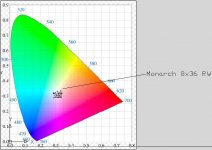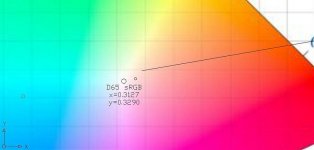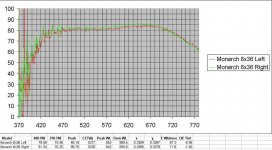Surveyor
The more I understand, the more I understand why I
Last Christmas I bought a pair of Nikon Monarch 8x36 ATB’s to carry in the vehicles as secondary binoculars. After some usage, I noticed that these were hard to focus, sometimes resulting in a sharp image and sometimes not. Both pairs exhibited the same problems but one pair was definitely inferior to the other. I gave the worse pair to my neighbor’s boy.
At this time, one of the BF members reported that he was having focus problems and a problem with general sharpness of an 8x36 and when I confirmed that I, too, was seeing the same thing it irritated some people when I said the Monarch 8x36 was not as sharp side by side with the alphas (gee!! imagine that).
Over this last Christmas I had lot of time to play and catch up on some stuff and I got the suspect 8x36 out to do some testing to see if I could find out why they acted as they did. The first thing I checked was the resolution of the two barrels and noticed something I had never seen before, when moving the focus control, the image would "bloom" a little, then settle down and made it hard to find a sharp focus. I thought about this and decided that on of the focus lenses must be twisting or flexing as it started to move. I figured a 1/5th the cost of the alphas this was probably still within specs as it settled to a decent image (I could accommodate it), just a little hard to focus. Next I checked the two tubes for magnification and was pleasantly surprised, 7.89x left and 7.91x right, far closer than most I have checked. Next I checked the collimation, I really did not expect what I found since I never had problems accommodating the image in my refrigerator collimator or in the field. I did hold them away from eyes and checked the horizontal line and I could see some offset, but it really did not appear as bad as it turned out to be. The results of the test were at 75mm IPD 16' divergence +45' vertical, @64mm IPD +6' divergence and +48' vertical and @52mm IPD -3' convergence and 48' vertical. The max for horizontal divergence is 100', convergence 40' and vertical 30'. As you can see, at my IPD the horizontal is as good as it gets, less than 1' in object space (I do my measurements in image space so you have to divide them by power to get to object space) but the vertical is about 160% of what the max should be. So I now think, instead of a lens movement (I could not remember if I saw the “blooming” when measuring a single tube or if looking at the double collimator), that there is a very brief time that I am seeing two images before the eyes or brain latches on and corrects.
I sent them back to Nikon and they received them Jan. 4.
On Jan. 10, I received a Nikon Service Acknowledgement/Estimate for $10 repair and $10 handling charge to be approved.
I received the binoculars back on Jan. 21 and started testing within a few days. The return slip only showed “adjusted and cleaned” for the work performed so I have no way of knowing if there was a focus lens mechanical problem.
The returned binoculars performed significantly better than before. The focus now “snaps” into focus faster and with more consistency than previously. The image is nice and sharp almost to the edge, about 80-85% I would say, but the resolution is not as good as the higher priced binoculars. The contrast is much improved though still could be better. Brightness is as expected. Color fidelity and saturation is very good. I did not notice any CA but conditions have been drab since their return and I am pretty immune to CA anyway. There is a little pincushion distortion, but not as much as most others.
All in all the performance is very good, impressive in fact, considering their price point. You probably will only notice their shortcomings when viewed side by side with an appropriate sized alpha class binocular. But you need to check them first since it seems that these can be out of specification readily.
Due to weather, cold, illness and just plain laziness I have not done any star testing yet (only looked to see if approximately round out of focus image with no booster). It may be awhile before I try that since I am in the process of changing my whole methodology for star testing.
Below is a list of a few of the “proof” items I have checked. I have done nothing about an estimated wavefront error as yet and do not know if I will pursue these any further since they now perform as I would expect them to. I would like to get to an estimated wavefront error just to see what a projected MTF (estimated, guesstimated) plot would look like.
Collimation before adjustment by Nikon
Measurements for instrument SN# BR206109
Nikon Monarch 8x36 ATB
Conditional measurements, axle not considered. Standard tolerance is arc minutes in image space and shown in brackets {}. Measurements made in image space, divide by power to obtain object space units.
’= arc minutes
IPD Step/Dip Divergence Convergence
75 mm 45’{30’} +16’{100’}
64 mm 48’{30’} +6’ {100’}
52 mm 48’{30’} -3’{40’}
Collimation after adjustment by Nikon
On return from Nikon the conditional collimation at my IPD setting was:
IPD Step/Dip Divergence Convergence
64 mm 25’{30’} +27’{100’}
These results are within the standard tolerance level and the dipvergence being just outside the high performance level of 20’.
Customary standard measurements
From manufactures specs.
Weight: 19.8 oz.
Size: Mid Size Binoculars
Eye Relief: 17
Waterproof: Yes
Features: Waterproof
Magnification: 8 X
Brand: Nikon
Dimensions (in): 4.9L x 5.1W
Series: Binoculars Series
Objective Lens Diameter: 36 mm
Field of View @ 1000 Yards: 376 ft.
Angular Field of View: 7 Degrees
Exit Pupil: 4.5 mm
Focus Type: Center
Close Focusing Distance: 8.2 ft.
Relative Brightness: 20.3
Binoculars Series: Monarch ATB Binoculars
Prism Type: Roof Prism Binoculars
My measurements: Estimates only, not traceable.
Entrance Pupil: Left=H36.5 V35.5 mm / Right=H36.0 V35.5 mm (5%)
Exit Pupil: Left= 4.6-4.7 mm / Right= 4.65-4.75 mm by Peak Optical Scale (10%)
Left= H4.662 mm V4.396 mm / Right= H4.717 mm V4.402 mm (10%)
Note: Due to parallax from not being able to get Peak optical scale down on curved eyepiece, a more accurate method is used. The trig metric observations were not made on the optical axis of the barrels so the averages were used to compensate. Average exit pupil measurement = 4.544 mm.
Weight= 24.5 oz./695 g w/harness and caps. (19.8 oz./561)
Resolution (2x boosted) Left= 9”/lp./Right= 8.1”/lp (“=arc seconds-300/D=8.33”)
Left=4.5”/line /Right=4.1”/line(“=arcseconds-60/power=7.5”)
Resolution just checked as a go/no go test. Did not try to take to best level. Note that the standard ISO calls for resolution for exit pupils greater than 4.5 mm to be 60/power in arc seconds. To me, this indicates that resolution is measured in lines/mm, or “detectable resolution”, instead of line pairs/mm. If anyone knows differently or can confirm this I would appreciate hearing from them. Most people use lp/mm convention that is primarily used for photography and printing applications.
Power(x) Left tube= 7.89x /Right tube= 7.91x (8x nominal-5%-2% inter-barrel)
FOV Left tube= 6.92 deg. / Right tube= 6.97 deg. (7 degrees nominal-5%)
Inter-barrel rotation= Between 0.0 and 0.5 deg. (1.5 deg.)
Note: Rotation appears to be zero but due to parallax and object space grid line width scale @48x, a range was added.
Zero diopter setting. Infinity=+0.25D / Close focus= -0.5D. (+/- 1D)
I am not sure about the calibration of the diopter markings on the 8x36. They are only marked by a zero mark with a plus and minus sign on either side, spaced about 6 mm. It seems that these may be about 1D but really a guess.
Chromaticity and band pass (my estimate only, not traceable)
Dominant WL=483.6 nm. Peak WL=641 nm. CCT= 5225K
81.3 Peak intensity at 641 nm. (Obtained by other methods)
77 average %T for 400-700 nm.
94.23% Peak/Avg. %T Ratio
Pk-3 db.=393-828 nm.
Available online is a report done by Gamma Scientific for the Monarch 8x42 ATB and available from Carson Optics that was used for comparison purposes. The results of my 2 cent effort is close enough to show some merit for further testing. Most results came within 5% of the pros results. Now, to find out if it is repeatable.
At this time, one of the BF members reported that he was having focus problems and a problem with general sharpness of an 8x36 and when I confirmed that I, too, was seeing the same thing it irritated some people when I said the Monarch 8x36 was not as sharp side by side with the alphas (gee!! imagine that).
Over this last Christmas I had lot of time to play and catch up on some stuff and I got the suspect 8x36 out to do some testing to see if I could find out why they acted as they did. The first thing I checked was the resolution of the two barrels and noticed something I had never seen before, when moving the focus control, the image would "bloom" a little, then settle down and made it hard to find a sharp focus. I thought about this and decided that on of the focus lenses must be twisting or flexing as it started to move. I figured a 1/5th the cost of the alphas this was probably still within specs as it settled to a decent image (I could accommodate it), just a little hard to focus. Next I checked the two tubes for magnification and was pleasantly surprised, 7.89x left and 7.91x right, far closer than most I have checked. Next I checked the collimation, I really did not expect what I found since I never had problems accommodating the image in my refrigerator collimator or in the field. I did hold them away from eyes and checked the horizontal line and I could see some offset, but it really did not appear as bad as it turned out to be. The results of the test were at 75mm IPD 16' divergence +45' vertical, @64mm IPD +6' divergence and +48' vertical and @52mm IPD -3' convergence and 48' vertical. The max for horizontal divergence is 100', convergence 40' and vertical 30'. As you can see, at my IPD the horizontal is as good as it gets, less than 1' in object space (I do my measurements in image space so you have to divide them by power to get to object space) but the vertical is about 160% of what the max should be. So I now think, instead of a lens movement (I could not remember if I saw the “blooming” when measuring a single tube or if looking at the double collimator), that there is a very brief time that I am seeing two images before the eyes or brain latches on and corrects.
I sent them back to Nikon and they received them Jan. 4.
On Jan. 10, I received a Nikon Service Acknowledgement/Estimate for $10 repair and $10 handling charge to be approved.
I received the binoculars back on Jan. 21 and started testing within a few days. The return slip only showed “adjusted and cleaned” for the work performed so I have no way of knowing if there was a focus lens mechanical problem.
The returned binoculars performed significantly better than before. The focus now “snaps” into focus faster and with more consistency than previously. The image is nice and sharp almost to the edge, about 80-85% I would say, but the resolution is not as good as the higher priced binoculars. The contrast is much improved though still could be better. Brightness is as expected. Color fidelity and saturation is very good. I did not notice any CA but conditions have been drab since their return and I am pretty immune to CA anyway. There is a little pincushion distortion, but not as much as most others.
All in all the performance is very good, impressive in fact, considering their price point. You probably will only notice their shortcomings when viewed side by side with an appropriate sized alpha class binocular. But you need to check them first since it seems that these can be out of specification readily.
Due to weather, cold, illness and just plain laziness I have not done any star testing yet (only looked to see if approximately round out of focus image with no booster). It may be awhile before I try that since I am in the process of changing my whole methodology for star testing.
Below is a list of a few of the “proof” items I have checked. I have done nothing about an estimated wavefront error as yet and do not know if I will pursue these any further since they now perform as I would expect them to. I would like to get to an estimated wavefront error just to see what a projected MTF (estimated, guesstimated) plot would look like.
Collimation before adjustment by Nikon
Measurements for instrument SN# BR206109
Nikon Monarch 8x36 ATB
Conditional measurements, axle not considered. Standard tolerance is arc minutes in image space and shown in brackets {}. Measurements made in image space, divide by power to obtain object space units.
’= arc minutes
IPD Step/Dip Divergence Convergence
75 mm 45’{30’} +16’{100’}
64 mm 48’{30’} +6’ {100’}
52 mm 48’{30’} -3’{40’}
Collimation after adjustment by Nikon
On return from Nikon the conditional collimation at my IPD setting was:
IPD Step/Dip Divergence Convergence
64 mm 25’{30’} +27’{100’}
These results are within the standard tolerance level and the dipvergence being just outside the high performance level of 20’.
Customary standard measurements
From manufactures specs.
Weight: 19.8 oz.
Size: Mid Size Binoculars
Eye Relief: 17
Waterproof: Yes
Features: Waterproof
Magnification: 8 X
Brand: Nikon
Dimensions (in): 4.9L x 5.1W
Series: Binoculars Series
Objective Lens Diameter: 36 mm
Field of View @ 1000 Yards: 376 ft.
Angular Field of View: 7 Degrees
Exit Pupil: 4.5 mm
Focus Type: Center
Close Focusing Distance: 8.2 ft.
Relative Brightness: 20.3
Binoculars Series: Monarch ATB Binoculars
Prism Type: Roof Prism Binoculars
My measurements: Estimates only, not traceable.
Entrance Pupil: Left=H36.5 V35.5 mm / Right=H36.0 V35.5 mm (5%)
Exit Pupil: Left= 4.6-4.7 mm / Right= 4.65-4.75 mm by Peak Optical Scale (10%)
Left= H4.662 mm V4.396 mm / Right= H4.717 mm V4.402 mm (10%)
Note: Due to parallax from not being able to get Peak optical scale down on curved eyepiece, a more accurate method is used. The trig metric observations were not made on the optical axis of the barrels so the averages were used to compensate. Average exit pupil measurement = 4.544 mm.
Weight= 24.5 oz./695 g w/harness and caps. (19.8 oz./561)
Resolution (2x boosted) Left= 9”/lp./Right= 8.1”/lp (“=arc seconds-300/D=8.33”)
Left=4.5”/line /Right=4.1”/line(“=arcseconds-60/power=7.5”)
Resolution just checked as a go/no go test. Did not try to take to best level. Note that the standard ISO calls for resolution for exit pupils greater than 4.5 mm to be 60/power in arc seconds. To me, this indicates that resolution is measured in lines/mm, or “detectable resolution”, instead of line pairs/mm. If anyone knows differently or can confirm this I would appreciate hearing from them. Most people use lp/mm convention that is primarily used for photography and printing applications.
Power(x) Left tube= 7.89x /Right tube= 7.91x (8x nominal-5%-2% inter-barrel)
FOV Left tube= 6.92 deg. / Right tube= 6.97 deg. (7 degrees nominal-5%)
Inter-barrel rotation= Between 0.0 and 0.5 deg. (1.5 deg.)
Note: Rotation appears to be zero but due to parallax and object space grid line width scale @48x, a range was added.
Zero diopter setting. Infinity=+0.25D / Close focus= -0.5D. (+/- 1D)
I am not sure about the calibration of the diopter markings on the 8x36. They are only marked by a zero mark with a plus and minus sign on either side, spaced about 6 mm. It seems that these may be about 1D but really a guess.
Chromaticity and band pass (my estimate only, not traceable)
Dominant WL=483.6 nm. Peak WL=641 nm. CCT= 5225K
81.3 Peak intensity at 641 nm. (Obtained by other methods)
77 average %T for 400-700 nm.
94.23% Peak/Avg. %T Ratio
Pk-3 db.=393-828 nm.
Available online is a report done by Gamma Scientific for the Monarch 8x42 ATB and available from Carson Optics that was used for comparison purposes. The results of my 2 cent effort is close enough to show some merit for further testing. Most results came within 5% of the pros results. Now, to find out if it is repeatable.
Last edited:






